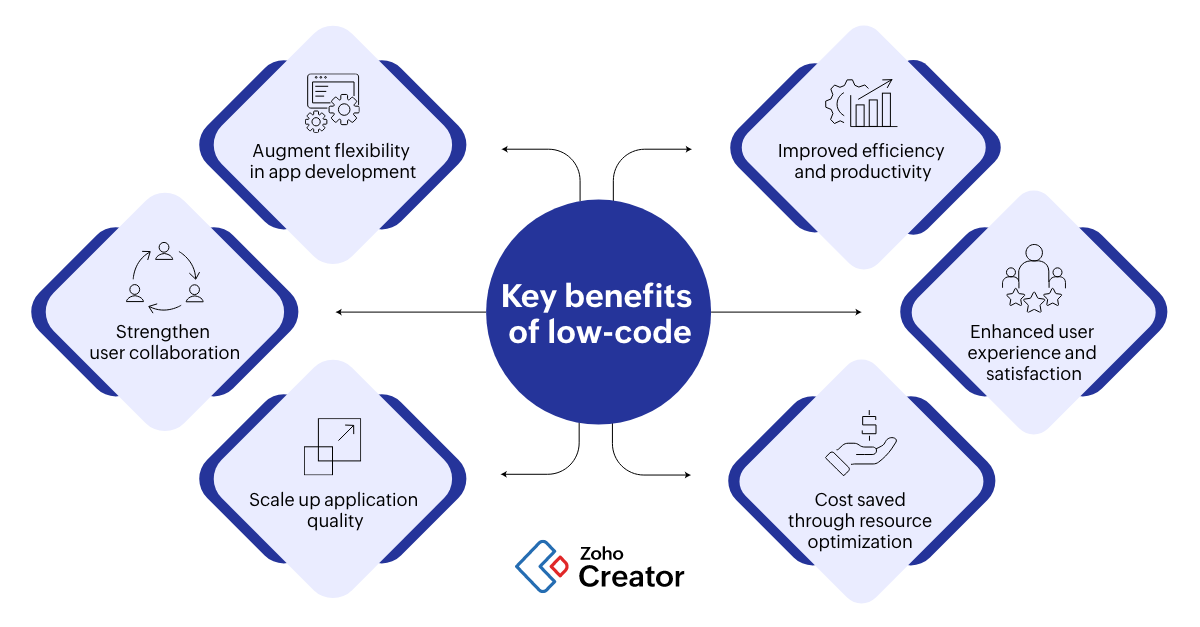Good News On Selecting Low-Code Platform Examples
Wiki Article
Benefits Of Low-Code Application Development In Terms Of Speed
Visual Development Environment:
Drag-and-Drop Interfaces: Low-code platforms provide visual tools for designing applications. Drag-and-drop elements allow developers to quickly build applications without writing long lines of code.
Pre-built Templates and Components: A lot of low-code platforms have templates and components that are pre-built, which allow developers to rapidly develop and test applications without starting from the beginning.
Coding needs that are reduced:
Automated Code Generation Low-code platforms automatically generate the code that is used to build the visual models developed by programmers. This helps reduce the need to code manually and speeds up the development process.
Reusable Components : Developers can reuse components across different projects, thereby reducing the time spent writing and testing codes.
Streamlined Collaboration:
Low-code development platforms are often equipped with tools like version control, deployment and testing. This allows seamless collaboration between teams.
Citizen Development: People who are not developers and business users can benefit from user-friendly interfaces to aid in the development of applications, which helps reduce bottlenecks triggered by a shortage of professionals to develop applications.
Rapid Iteration & Prototyping
Fast prototyping: Developers can create prototypes quickly to test concepts and get feedback. This results in a shorter iteration cycle.
Easy Modifications. The visual nature low-code development gives makes it simple to update and change applications. This speed up the process of enhancing and improving applications by incorporating user feedback.
Pre-built Integrations:
API Integrations. A number of low-code platforms offer connectors that are designed to work with popular APIs and services. This can reduce the time to integrate systems.
Data Integration: The instruments integrated into the software simplify and accelerate the process of linking databases, applications and data sources.
Deployment Scaling
One-Click-Deployment: Many Low-Code platforms offer one click option for deployment. This reduces the time and efforts required to deploy an application.
Cloud-based solution: Cloud based low code platforms can handle the management of infrastructure and scale. This lets developers concentrate on applications' logic, functions and features rather than deployment logistics.
The efficiency of developing low-code applications lies in its ability to simplify and automate many aspects of the development process. This allows quicker development of apps as well as faster adaptation to changes in requirements. Check out the top Low-code Platform for application development for more advice including rapid app development, microsoft azure sql, cross platform mobile development, jdbc server, software for app development, sso azure, driver jdbc, application modernisation, stored sql procedures, develop mobile application and more.

Advantages Of Low-Code Application Development In Terms Of Governance And Security
Low-code application development offers several benefits in terms of security and governance. These are crucial to ensure that applications are safe and secure. They also ensure that they are well-managed throughout their lifespan. Here are the most significant benefits: Centralized Governance
Unified Management Console: Low-code platforms have a central administration console to allow administrators to control and supervise every application. This ensures consistent governance across the company.
Role-Based Access Control RBAC (RBAC). These systems typically have robust access control that is that is based on roles, giving administrators to create and enforce their own access policies. This ensures that only authorized users are able to access or modify particular elements of an application.
Compliance and Regulatory Adherence
Built-In Compliance Features: Many low-code platforms are designed to conform to industry standards and regulations (e.g. GDPR, HIPAA). They have frameworks and tools that help to ensure applications meet these requirements.
Audit Trails and Logging: Comprehensive logging and audit trails are typically integrated, allowing organizations to keep track of changes, monitor access and ensure compliance with internal and external laws.
Additional Security Measures
Data Encryption: Low-code platforms typically provide built-in encryption for data that is in storage and while in transit, making sure that data sensitive information is secured.
Security Certifications: A lot of low-code companies have security certifications (e.g., ISO 27001, SOC 2) that demonstrate adherence to high security standards. This provides extra security for users.
Automated Security Updates
Regular Updates and Patches Low code platforms typically are equipped to handle patches and security updates regularly. This helps ensure that applications remain protected from the latest threats without the need for developers to manually alter their settings.
Security Monitoring: Continuous security monitoring tools are typically included, providing real-time alerts as well as insights into security risks that might be present.
Data Governance
Data Access Policies These platforms enable organisations to create data access rules and enforce them, ensuring data is available only to those who have been granted access. They also ensure the data is used correctly.
Data Masking and anonymization: The built-in tools for masking data and anonymization can help safeguard sensitive data, particularly in development and testing environments.
Consistent Lifecycle Management of Applications
Development and Deployment Pipelines Low-code platforms usually offer integrated development and deployment pipelines that incorporate security checks to ensure that security remains intact throughout the entire application lifecycle.
Version Control. Integrated version management can help identify and reverse any modifications that are made to the program, while ensuring that its integrity is maintained.
User authentication authorization
Single Sign On (SSO) Single Sign On (SSO): Supporting single sign on as well as other advanced authentication techniques simplify management of users while increasing security.
Multi-Factor Authentication A lot of platforms come with built-in support of multi-factor authentication. This adds an extra layer of security to the applications.
Policy Enforcement and Compliance monitoring:
Low-code platforms often come with pre-defined policies templates that allow organizations to establish security and governance policies swiftly.
Compliance Monitoring Tools: They give continuous monitoring and a report on compliance status. This makes it easier to detect potential issues and take action to address them.
Integrate into existing security infrastructures:
Seamless Integration: Low-code platforms are designed to integrate seamlessly with the existing security infrastructure and tools, including identity management solutions SIEMs (Security Information and Event Management Solutions), and firewalls.
API Security API Security: Built-in API security features ensure that integrations with other systems are safe, safeguarding information and ensuring the integrity of the application.
Training and the best practices
A lot of platforms provide guidelines and best practice for developing secure applications. They can help developers who are not developers to adhere to security standards.
Some lowcode providers offer resources and security training for users to learn how to create and maintain secure application.
Overall the governance and security advantages of low-code application development make sure that applications are created and maintained in a safe as well as compliant manner. These platforms provide the tools and frameworks needed to secure sensitive data as well as enforce policies and ensure regulatory compliance, while facilitating management and oversight. See the most popular our site for blog examples including rapid action development, low code development platforms, app dev platform, cross platform app development, jdbc server, low code development platforms, no code platforms, push alerts, paas service, database in azure and more.

In Terms Of Vendor Support And Community Involvement, Low-Code Development Can Bring Many Advantages.
Low-code platform development offers significant advantages, including support from vendors and a community support. This is vital for ensuring the success of application implementation along with ongoing maintenance and continual improvement. These are the main benefits:Vendor support
Comprehensive Technical Support:
Support Teams: Several platforms using low-code have designated support teams that can help with technical issues as well as troubleshooting and advice.
24/7 Support Availability: Some companies provide 24/7 support, which is particularly beneficial for companies that are global and operate in different time zones.
Training and Onboarding
Training programs that are structured: Vendors offer structured training courses, such as webinars or certification courses. This helps users to quickly grasp the platform.
Personalized onboarding: Many companies offer tailored services for new customers, to help them implement the platform properly and to tailor it to suit their needs.
Regular Updates and enhancements:
Continuous Improvement Platform vendors typically release regular updates with new features, performance improvements as well as security patches. This ensures that the platform remains up-to date and secure.
Feedback Integration: Vendors incorporate user feedback in their development cycles to ensure that the platform is continually evolving to meet the changing requirements of their users.
Comprehensive Documentation:
Documentation - Detailed detailed and well-organized document covering everything from basic use to advanced customisations are often accessible. This lets users solve issues on their own.
API References: API documentation is detailed and aids developers in integrating the platform with other systems and to further customize their applications.
Professional and Consulting Services
Expert Consultation: Vendors frequently provide consulting services to help with planning for strategic purposes, architecture design, and complex implementations, ensuring that users can leverage the platform to its fullest potential.
Custom Development Service: A few vendors offer custom development to build functionalities or integrates for their customers which are not easily accessible.
Community Support for the Community
Active User Community:
Forums and Discussion Boards Many low-code platforms have vibrant online communities in which users can seek answers, discuss solutions, and collaborate on best practices.
Virtual and local User Groups: These groups provide opportunities to network, learn and share knowledge.
Collaboration and knowledge sharing:
Community-Contributed Resources: Users often share templates, modules, and extensions that they have developed, which can be reused or adapted by others, accelerating development and innovation.
Crowdsourced problem solving: The collective knowledge and experience of the community can be an excellent resource when it comes to tackling problems and coming up with innovative solutions.
Learning and Development
Community-Led Learning: Many communities hold workshops, training sessions, and webinars which are typically run by experienced users who can provide insights and more advanced methods.
Online Tutorials & Courses: The community members frequently make online tutorials, courses, and guides for how to perform tasks that enhance learning resources.
Feedback and Influence
Forums for Product Feedback: These forums typically provide feedback to the manufacturer, which can influence the development of new features and improvements.
Beta Testing Programs Participants in the Community who are active be able to participate in beta programs. This gives them an early glimpse of the latest features, as well as a chance to help shape the future of the platform.
Recognition and Support
Community Recognition Programs: A lot of vendors offer recognition programs for active members of the community. Some examples include MVP (Most Valuable Professionals) that recognizes contributions.
Peer Support: Members of the community typically provide peer support, sharing their expertise and providing guidance to users who are not as familiar in a supportive and supportive environment.
Overall, the combination is robust vendor and active, engaged communities that provide a comprehensive environment for support of low-code applications development. This ensures that users can access the tools as well as the expertise and collaboration opportunities required to effectively develop, deploy, and maintain their apps, ultimately enhancing the efficiency and effectiveness of their applications.
